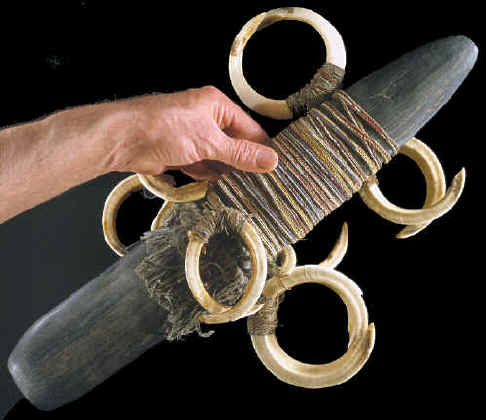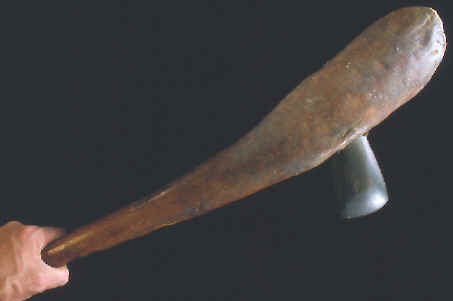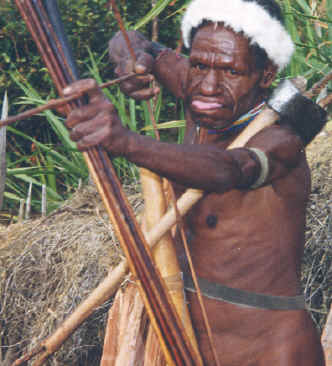|
Display-exchange stones are described by the people using
them with human
anatomical terminology. The narrow end is called the head or skull (uguloak) and the
wider end is called the anus (alokhe). If the stone is curved, rather than
perfectly flat, the concave surface is called the face or cheekbone and the convex side
is called the back (opolikhe). But even though the people using them refer to the
stones with anatomical terms they don't see them as representing human beings
or even as male or female entities. This issue is complicated though,
because when the stones are laid out in a row with other stones in the
funeral bundle, the group together can be seen as representing a human
figure. Also, if a display-exchange stone is converted into a sacred stone
it can be empowered with the ability to become a container for a human
spirit. (1999:
Hampton, p. 105).
|
|

CLICK ON
PICTURE FOR LARGER IMAGE
DECORATED DISPLAY-EXCHANGE
STONE
DANI
CULTURE
IRIAN JAYA, INDONESIA
PETE BOSTROM COLLECTION

CLICK ON
PICTURE FOR LARGER IMAGE
A
MISSIONARY'S CHURCH--1949
PAPUA NEW GUINEA
"This display-exchange stone was collected in September of 1995 in a
small Loni compound in the loosely knit village of Ibele. It was
reputed to have special powers and was one of the most sacred
objects of the compound. It was offered with much secrecy and not a
small amount of fear by the second headman of the compound whose
name was Yan. Some of the tusks and trinkets tied to this stone were
said to be offerings for the dead son of the headman, Hecky who had
recently died when their sleeping hut burned" (1996: Konder).
It was suggested that Yan gave this stone away because of the influence
the local missionary was having on the people. Some were wanting to
get rid of the stones and some were wanting to keep them. A
reverend's statement in Papua New Guinea: "We burnt lots of
magic paraphernalia which was brought in.
This display exchange stone is adorned with an
assortment of decorations. It has two different skirt designs. One
is the brief wrap around wedding skirt (jogal) style and the other
is one of the different forms of drop skirts. The wrap around skirt
on this example is made of natural cording along with various colors
of what appears to be plastic string or tape braided in. There are
also seven boar tusks attached to the skirts. The color of this
stone is a very dark green. This display-exchange stone measures 19
3/16 inches (49.2 cm) long, 3 1/16 inches (7.7 cm) wide and 1 5/16
inches (3.3 cm) thick.
Hampton suggests that display-exchange
stones evolved from flat and tubular style axe blades
(1999: Hampton, p. 294). Some exchange
stones, like this example, are shaped like axe blades and have
sharpened blades. |
|
|
Some display-exchange stones are decorated or
"dressed." They are commonly wrapped with a female skirt design,
however the stones are not seen as either male or female objects. These miniature
skirts are made from either orchid fiber cording, flattened reeds, fiber
strings or bark strand cloth. Stones may be decorated with as many as three
different designs of skirts. The skirts sometimes have additional decorations
in the form of fur and feathers from the cuscus marsupial, tree kangaroo, tree
rat, ground rodents, parrots and other birds. Pig tails, cocoons and boar
tusks might also be used but they are more commonly applied to sacred stones.
Items placed on exchange stones are considered just mementoes but they do have
male or female references. Fur, feather, pig tails and boar tusks are male
themes. The stones are sometimes maintained as they are received. If they were
received "naked" they are left that way or if they are received
"dressed" they are maintained that way also.
|
|

PAINTED AXE BLADE
DANI
CULTURE
IRIAN JAYA, INDONESIA
PETE BOSTROM COLLECTION
This painted axe blade was collected in September of 1995 from a Loni
compound in the village of Ibele. It was given away to the Americans
who were in the village at the time. According to the story, it was
given away at the request of the local missionary who wanted to get rid of
some of these types of ritual artifacts. Stones used to cut off the
fingers of small girls to appease the ghosts at funerals is another
example of the types of stone tools that's discouraged by the
missionaries. It was suggested that this stone was somehow involved
in the finger cutting process. The fact that this stone is painted
suggests that it was not used as a normal wood cutting tool, but was
involved in some sort of ceremonial context. This axe blade measures
6 1/2 inches (16.5 cm) long, 2 1/8 inches (5.3 cm) wide and 1 5/16
inches (3.3 cm) thick. |
|
|
The sources for the stone from which the Dani
display-exchange stones were made came from mainly two quarry sites. Most of
them were manufactured at the Yeineri quarry complex and a smaller number
originated from the Tagime quarries. Other examples may have come from sources
of opportunity. They were made from bluechist, epidote amphibolite; amphibole
schist; epitote chlorite schist; and light green, gray and black slate
(1999:
Hampton, p. 108). All the
examples illustrated in this article are made from a stone that is harder than
slate..
|
|

HAFTED STONE AXE
DANI
CULTURE
IRIAN JAYA, INDONESIA
PETE BOSTROM COLLECTION
This hafted axe was collected sometime in the 1950's in the village
of Tiragupkunik. Axes are much rarer that adzes. Adzes are much more
commonly used and they are the only tool the people use to cut down
trees. Axes are used only to split wood. One survey among the Dani
revealed 10 adzes for every axe within a village or compound. This
example measures 29 inches (73.6 cm) long. |
|
|
As for the
value of display-exchange stones, the longest stones are considered the
most valuable with the color also being a factor. But the width and any
applied decorations are not considered very important. The stones can be
traded for a wide variety of things but their value in reference to pigs
is the common denominator. For instance, a display-exchange stone
measuring 27 1/2 inches (70 cm) long would be worth a large pig and a
medium sized stone might would be worth a medium sized pig. This is a
general concept of what they are worth
(1999:
Hampton, pp. 113-114).
Another concept of value in New Guinea involves
a decision made by one of the courts in the newly formed legislative
council in Papua New Guinea (western half of the big island) in the
1970's. The case involved a bride price when a group of young men got
together and claimed they could no longer get married because the bride
price had become to high. The judge's final decision was that a new
bride is worth five pigs, one cassowary (bird) and 300 Australian
dollars. Also, if a woman had already been married once, the price drops
to two pigs, one cassowary and $37.50. Further, if a woman had been
married more than once there would be no more commercial value!
(1978:
Marcus p.113)
|
|

PICTURE
CREDIT AND COPYRIGHT, AL KONDER & SANDY DONNELLY
YADIUS FROM THE
VILLAGE OF MELEDIK
IRIAN JAYA, INDONESIA
This is Yadius from the village of Meledik in Irian Jaya. It's about
the year 1995 and he is trading the bow and arrows he is holding.
Notice that the axe he is carrying is metal. Not long ago he would
have been using a stone axe. Also notice that the end of the axe
handle is forked for the purpose of picking up heated rocks to cook
food in a dug pit lined with leaves. He is also wearing the
traditional penis gourd. |
|
|
Primitive cultures in New Guinea are impressively
complex. Scientists working there have learned much about the ritual use of
stone artifacts. This information is invaluable to archaeologists who are
studying cultures that are no longer living. The knowledge that has been
gained from the studies of the display-exchange stones in the Dani
region of Irian Jaya is extraordinary.
|
|
"REFERENCES"
1968,
Gardner, Robert & Heider, Karl G., "Gardens of War, Life and
Death in the New Guinea Stone Age," p. 87.
1970, Heider, Karl G., "The Dugum Dani," p. 288.
1978, Marcus, Rebecca B., "Survivors of The Stone Age," p.
113.
1998, Konder, Albert, Personal Communication, Letter.
1999, Hampton, O. W., "Culture of Stone, Sacred and Profane Uses
of Stone Among the Dani,"
|
|
HOME
ORDERING |





